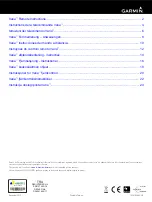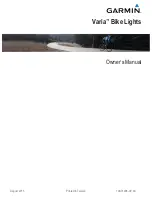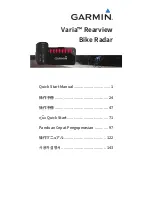
User’s Manual
Electric Bike
11
12
Step 6: Brake Adjustments
The brakes on your bicycle should be correctly adjusted from the factory. However, as
cables do seat and stretch. It is important to check the function of your brakes after
your first ride. Most brakes will need some adjustment after being used a few times.
Basic Disc Brake Adjustment
The following instructions are not exhaustive. We strongly suggest you take your bike
to your place of purchase, professional bike shop, or certified ebike mechanic for
assembly, adjustment, and maintenance.
A. Brake Lever and and Brake Pad Travel Adjustment
You can adjust the amount of braking leverage by adjusting the brake lever travel and
by the closeness of the brake pads to the brake disc.
Brake Lever/Cable Adjustment: To adjust
the travel of the brake lever, loosen the
Locking Collar A1 (away from lever body),
turn/unscrew the Adjusting Barrel A2
(what the cable enters) left/counter-
clockwise which tightens cable tension
and increase lever travel & leverage, this
will bring the caliper brake pads closer to
the disc
(Fig. 15).
If the pads are rubbing
against the disc, reverse the process.
If you have tuned the Adjusting Barrel
to its maximum and the lever travel is
still excessive you will have to adjust the
space between the pads and the disc.
Tighten the Locking Collar up to the lever body.
Additional adjustments at the caliper
(Fig. 16).
Caliper Adjustment: Insert a hex key into the smaller hole inside hex key hole B
(Fig.16)
. Rotating the allen key clockwise/right pushes the outer brake pad forward by
approx.0.8mm. After each turn, check the braking function, so the pads are close, but
do not rub the disc.
Fig. 13 Brake Lever Adjustment
Fig. 14 Disc Brake Pad
Adjustment
Fig. 15 Disc Brake Pads
Adjustment
Smaller Keyhole
Inside Main Hole
Fig. 15
Fig. 16
Fig. 17
Once the correct amount of travel has been reached, centre the brake Caliper on the
disc by adjusting screw C
(Fig. 17)
. When the brake pads are centered on the disc the
wheel should spin freely with no rubbing. Upon applying the brake(s), there may be
a slight amount of noise until the pads “bed” in, this should stop after your first ride.
Make sure there is no oil or grease on your hands or on the disc which can degrade
brake performance.
B. Checking Brake Pad Wear, Pad Replacement
Pads that are 1mm thick (or less) need immediate replacement
(Fig. 18).
To install new pads, remove the brake caliper from the fork or frame by unscrewing
hex bolts D
(Fig. 19).
Unscrew (left/counterclockwise), the smaller hex bolt inside allen
bolt B (Fig.14). Lift up and pull the inner pad downward, using the protruding tab. Slide
a thin slot screwdriver under the outer pad and lift it up. Hold the screwdriver in this
position and remove the pad with a pair of long- nosed pliers.
Remove the springs from the worn-out pads and fit them onto the new pads. Replace
the new pads, keeping them slightly inclined into the seat of the Caliper.
Check that the spring hooks correctly onto the small piston. (When pulling downwards
the pads should not come out). Refit the Caliper to the fork (or frame for rear brake).
Turn adjuster screw C
(Fig.17)
until the pads are centered on the disc and the wheel
spins freely. Again, there may be some noise from the brake until it “bed” in. You may
have to adjust the cable tension and lever adjustment - follow previous Step A. Brake
Lever and and Brake Pad Travel Adjustment.
We strongly advise you have your brakes periodically checked and maintained by your
dealer or a professional bicycle mechanic.
Fig. 16
Fig. 17
Fig. 18
Fig. 19
A1
A2































